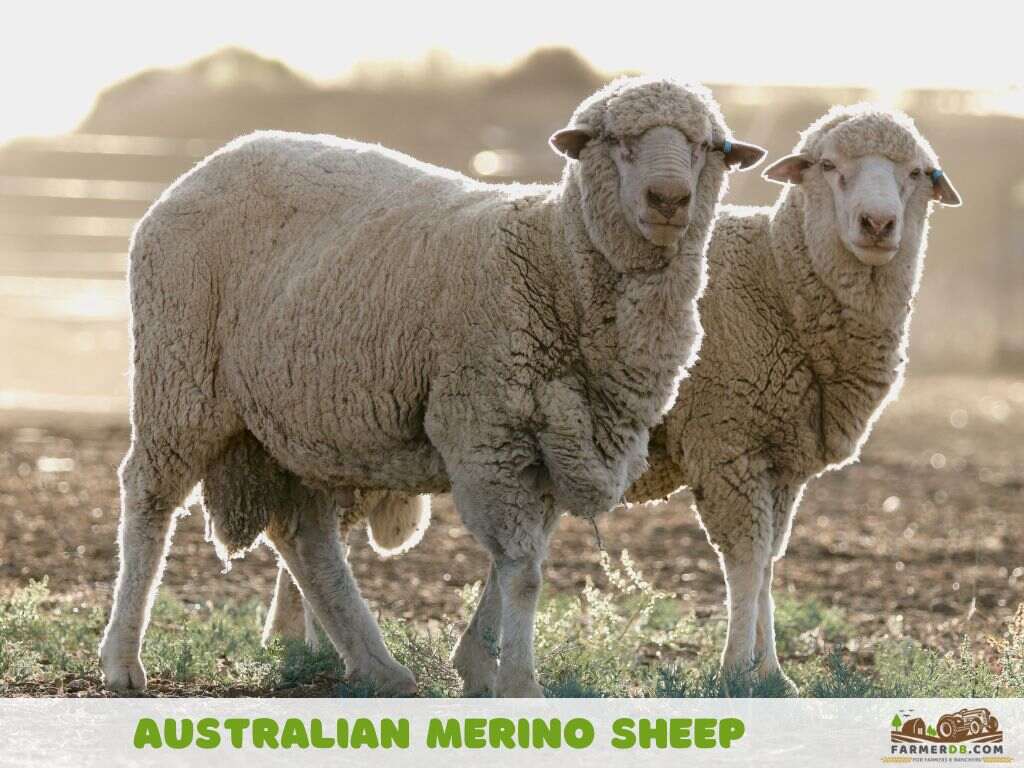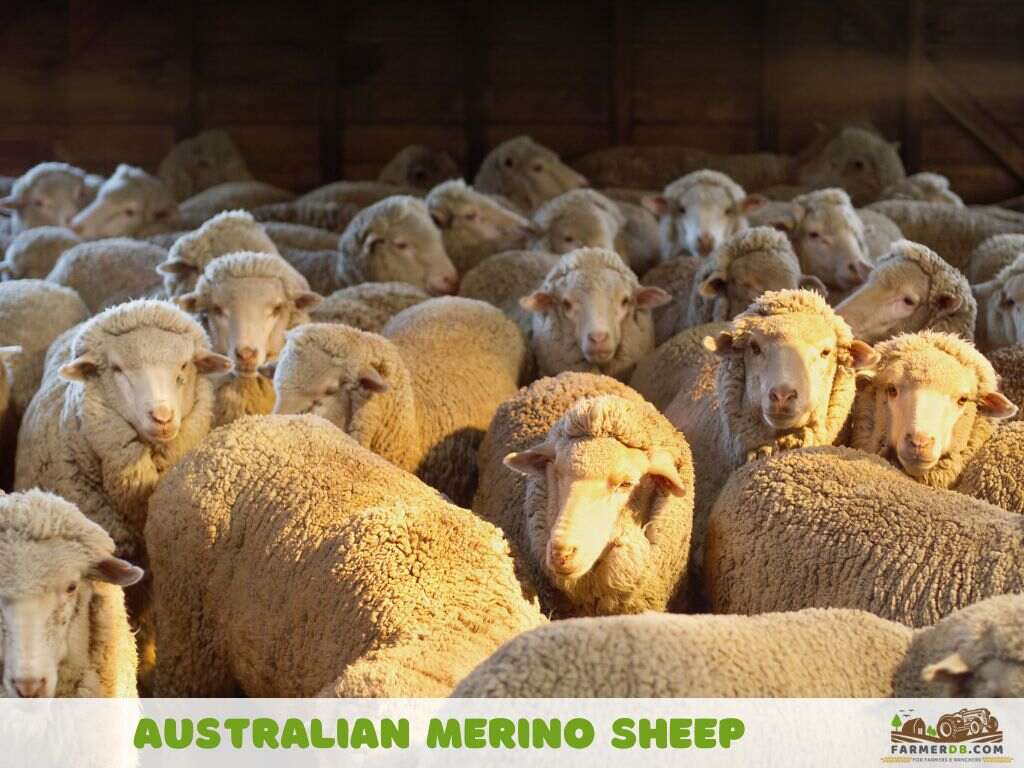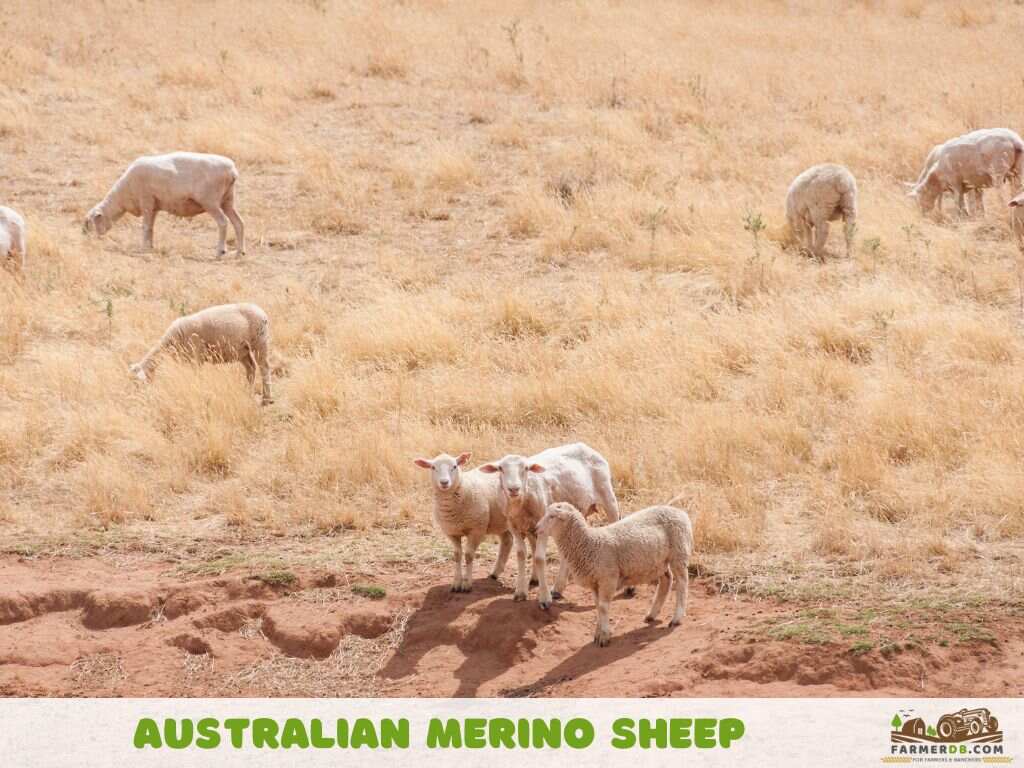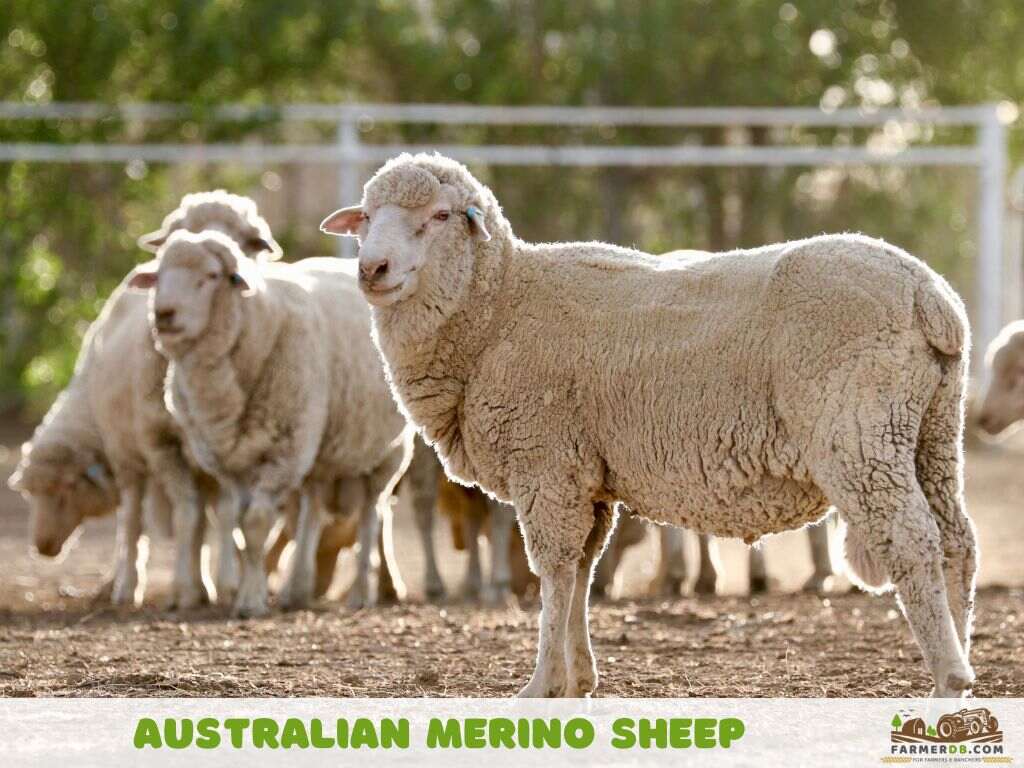The Australian Merino originated from Spanish Merino sheep, which were sent by Charles IV of Spain as a gift to the Dutch Republic.
The sheep did not adapt well to the climate there but did well in the Dutch Cape Colony, now part of modern-day South Africa.
Some of these sheep were later brought to Australia by John Macarthur in 1796, laying the foundation for the Australian Merino. By 1830, the Merino population in Australia had grown to nearly two million.

Since 1796, the Australian Merino has evolved significantly. Today, it is not just a single breed but a collection of strains, each developed to suit Australia’s diverse environments.
These strains were created through selective breeding, as farmers needed sheep that could adapt to different climates and farming systems across the country.
Nowadays, technology is a big part of Australian Merino breeding. Farmers use scientific tools along with traditional methods to assess an animal’s genetic potential. DNA testing is becoming more reliable, and modern techniques like artificial insemination and embryo transfer are already common.
Contents
Peppin Merino
The Peppin Merino is the most widely raised Merino strain, with 70 percent of today’s Australian Merinos tracing their lineage back to Peppin-developed sheep.
History
The Peppin Merino was developed in the 1870s by the Peppin family, who migrated from England.
Settling in Australia, they needed a stronger breed that could withstand the harsh climate. With the help of wool expert Thomas Shaw, they created a larger, more resilient sheep that could walk long distances to find water while producing thick, high-quality wool.
Their work led to the establishment of the Wanganella Stud in 1861, producing wool that became highly desirable in England’s tweed industry.
After George Peppin’s death in 1876, the Peppin properties changed hands multiple times, eventually being consolidated by the Falkiner family.
Today, the Bell Group of Companies owns the stud and continues to uphold its legacy. The bloodline remains strong and is still exported globally.

Size
The Peppin Merino sheep strain is medium to large in size, with a strong, robust body and long, straight legs.
Lifespan
This sheep strain can live between 10 and 13 years.
Habitat and Distribution
The Peppin Merino is found in Queensland, the slopes and plains of New South Wales, northern Victoria, and the farming regions of South Australia and Western Australia. Because it is highly adaptable, it also lives in rainy areas of Victoria, Tasmania, and New South Wales.
Wool
Peppin Merino wool has a fiber diameter that ranges between 20 and 23 microns and is known for being fine and soft.
A stud ram can produce up to 39.68 lbs (18 kg) of wool each year. In commercial flocks, it is common for these sheep to produce around 22.05 lbs (10 kg) of wool annually.
South Australian Merino
History
The South Australian Merino originated from sheep that were initially in the eastern states of Australia and were bred with the goal of improving certain traits, such as larger body size and dual-purpose use.
By the 19th century, South Australia had developed its own distinctive strain of Merino, adapted to the region’s semi-arid conditions.
Size
The South Australian Merino has a large body size and is the biggest among Merino strains in Australia.
It is taller, longer, and heavier than Peppin sheep, with smoother skin and fewer wrinkles.
Lifespan
This sheep has a lifespan of 10 to 15 years.
Habitat and Distribution
They are found in South Australia, where they were developed to live in dry pastoral regions with low rainfall, around 9.8 inches (250 mm) per year or less. Beyond South Australia, this strain of Merino is also found in pastoral regions of Western Australia, Queensland, and New South Wales, where the arid conditions make them well-suited for wool production.
Weight
These sheep can reach a carcass weight of around 48 to 55 lbs (22 to 25 kg) at 10 to 12 months of age. At maturity, they weigh between 154 to 165 lbs (70 to 75 kg).
Wool
South Australia Merino contributes approximately 16.7% of Australia’s total wool production.
This sheep strain is classified as a strong-wool Merino, which means it produces a heavier and more durable fleece. Strong-wool Merino fleece is resistant to wear and is blended with polyester and acrylic fibers to create affordable, mid-weight suiting fabrics and jersey wool garments.
These sheep produce 15.4 to 17.6 lbs (7 to 8 kg) fleece with a staple length of around 3.9 inches (100 mm) and a fiber diameter of 23–25 microns.
Saxon Merino
Size
Compared to other Merino strains, the Saxon Merino is the most compact, being the smallest of all Australian Merinos.
Lifespan
Their life expectancy is around 10 to 12 years, which is similar to other Merino strains.
Habitat and Distribution
It lives in areas with high rainfall, such as the highlands of Tasmania, the cooler parts of Victoria, and the elevated regions of New South Wales.
Wool
The Saxon Merino produces the lightest fleece and is used in the textile industry to create high-quality fabrics.
Its wool is bright white and soft to the touch, with fine fibers that vary in thickness. Wool with a 14-micron diameter produces about 6.6 lbs (3 kg), while 17.5-micron wool can yield up to 13.2 lbs (6 kg).
The wool has a helical crimp, which gives it natural elasticity. This allows it to spring back into shape after being stretched, making it ideal for lightweight, comfortable fabrics.
Unlike other Merino strains with a flat, wave-like crimp, Saxon Merino wool has a three-dimensional crimp. This structure helps it absorb dyes better, making it perfect for soft pastel-colored fabrics with a luxurious feel.
Booroola Merino
History
The Booroola Merino strain was developed by the Seears family in the Cooma district of New South Wales between 1916 and 1960. This type of Merino became well known for its very high fertility, which was achieved through careful breeding and selection over many years.
One ewe in this flock reportedly gave birth to more than 25 lambs in her lifetime.
Later, the CSIRO and the NSW Department of Agriculture took part of the Booroola flock for genetic research. By 1996, the last known Booroola sheep were kept at Trangie Research Station and later moved to Armidale (NSW) under CSIRO management.
Even though efforts have been made to protect Booroola genetics, their future remains uncertain as their numbers have declined over time.

Fertility
Unlike regular Merinos, which usually have one or two lambs, these sheep can have three or more lambs in one pregnancy. This makes them different from other Merino types.
Researchers discovered that the FecB gene is responsible for multiple births in sheep. In Booroola Merinos and other breeds that carry two copies of this gene, ewes can experience four times more ovulations, resulting in higher birth rates.
Farmers use Booroola Merinos in breeding programs to help other sheep breeds have more lambs. Their special genes have been added to different flocks around the world to increase birth rates.
In the United States, they were introduced and tested at Agricultural Research Stations. Their genetics were used to improve the fertility of American sheep breeds, such as through crossbreeding with Rambouillet ewes. These efforts aimed to boost lambing rates and improve overall productivity in U.S. sheep farming.
Size
These sheep have a small to medium body size. They are not as large as Peppin Merinos, but they are also bigger than Saxon Merinos.
Lifespan
This strain has the potential to live a standard lifespan of around 10 to 12 years, like most sheep.
Wool
The Booroola Merino produces 9 to 15 lbs (4 to 6.8 kg) of fleece before cleaning. After processing, 55-70% of the wool can be used for making fabrics.
The staple length of the wool is 3 to 4 inches (7.6 to 10.2 cm), which is shorter than some other Merino types but still good for making fine wool products. The fiber diameter is between 18 and 23 microns, meaning it is fine wool but not as soft as the finest Merino wool.
There is no official USDA Wool Grade for this wool, but it is still used in blended textiles, clothing, and other wool products.
Poll Merino
History
The Poll Merino is a hornless type of Merino sheep, developed in Australia through selective breeding. Most Merino sheep have horns, but some were born without them and were called “sports.” Farmers carefully chose and bred these hornless sheep to create a stable polled breed.
A major step in the breed’s development came in 1934, when Otway Falkiner established the Poll Boonoke Merino Stud, recognized as the first commercial Poll Merino flock. Falkiner selected eight strong, hornless rams from a flock of 9,000 Boonoke Merino rams and bred them with 400 carefully chosen Merino ewes. These sheep proved to be adaptable and easy to manage, maturing faster and avoiding common issues like blowfly strike around the head.
The Poll Merino Breeders’ Association of Australia (PMBA) was established in 1956, recognizing Boonoke as Poll Flock No. 1.

Size
In terms of size, these sheep are between medium and large, much like other Merino strains.
Lifespan
These sheep can live for a full lifespan of around 10 to 12 years.
Habitat and Distribution
They are found throughout Australia and in different Merino bloodlines.
Wool
Their wool depends on their bloodline, as they are found in fine, medium, and strong wool types.
Classification of Wool in Australian Merino Sheep Strains
Australian Merino sheep produce different types of wool based on fiber diameter. The wool classification is divided into three main categories: fine wool, medium wool, and strong wool, with further subcategories for finer classifications.
Fine Wool
These types of wool come from smaller-framed Merino strains, have very fine fibers, and are used in fashion clothing.
- Extra Ultrafine Wool: 16.0 microns and finer
- Ultrafine Wool: ≤ 17.5 microns. Extra ultrafine and ultrafine are often blended with silk and cashmere for luxury fabrics.
- Superfine Wool: 17.6 – 18.5 microns. This is used in high-quality textiles for lightweight suits and knitwear.
- Fine Wool: 18.6 – 19.5 microns. You can find it in premium wool clothing.
- Fine-Medium Wool: 19.6 – 20.5 microns
Medium Wool
This type of wool is the most common among Merino wool varieties and is widespread in Australia, mainly in the pastoral areas of NSW, Queensland, Victoria, South Australia, and Western Australia.
- Medium Wool: 20.6 – 22.5 microns in fiber diameter with a staple length of 3.54 to 4.53 inches (90 – 115 mm). It is applied in the production of light suiting fabrics, knitwear, and commercial textiles.
Strong Wool
This type of wool comes from larger-framed Merino sheep, which are often bred for both wool and meat production. Strong wool is more durable and is used in heavier textiles.
- Strong Wool: 22.6 microns and above in fiber diameter with a staple length of approximately 3.94 inches (100 mm). This wool is blended with polyester and acrylic to produce cheaper suiting fabrics and jersey wool, and it is also used in automobile and aircraft seating and interior fabrics.
Advantages
- Superior wool fiber
- Good temperament
- Hardy and resilient
- Long lifespan
- Adaptable
- Used in crossbreeding programs
- Long lifespan
Disadvantages
- Prone to flystrike
- High maintenance
- Nutritional sensitivity: Wool quality depends on proper feeding, requiring good pasture management.

Do you have any experience with the topic discussed here?
Would you like to improve the information shared and contribute your practical knowledge on the subject?
Your real-world experience as a farmer or rancher could greatly benefit other members, and the community would deeply appreciate your contribution.

